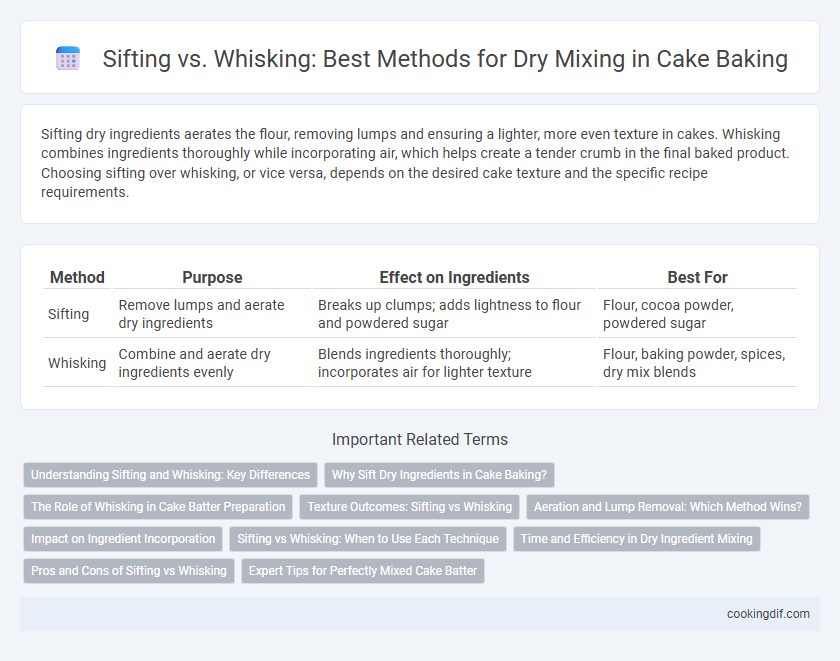Sifting dry ingredients aerates the flour, removing lumps and ensuring a lighter, more even texture in cakes. Whisking combines ingredients thoroughly while incorporating air, which helps create a tender crumb in the final baked product. Choosing sifting over whisking, or vice versa, depends on the desired cake texture and the specific recipe requirements.
Table of Comparison
| Method | Purpose | Effect on Ingredients | Best For |
|---|---|---|---|
| Sifting | Remove lumps and aerate dry ingredients | Breaks up clumps; adds lightness to flour and powdered sugar | Flour, cocoa powder, powdered sugar |
| Whisking | Combine and aerate dry ingredients evenly | Blends ingredients thoroughly; incorporates air for lighter texture | Flour, baking powder, spices, dry mix blends |
Understanding Sifting and Whisking: Key Differences
Sifting aerates dry ingredients, breaking up clumps to ensure even distribution and a finer texture in cakes, while whisking combines ingredients by incorporating air to create a light, fluffy mixture. Sifting primarily improves texture and consistency by removing lumps and evenly mixing, whereas whisking also builds volume and lightness, crucial for sponge cakes and meringues. Understanding these key differences allows bakers to choose the right technique to achieve desired cake structure and crumb quality.
Why Sift Dry Ingredients in Cake Baking?
Sifting dry ingredients like flour, cocoa powder, and baking soda in cake baking helps to aerate the mixture, ensuring a lighter and fluffier cake texture. It also removes lumps and evenly distributes leavening agents, which promotes consistent rising and prevents dense or uneven crumb structure. Proper sifting improves ingredient incorporation, resulting in a smooth batter and a more tender final cake.
The Role of Whisking in Cake Batter Preparation
Whisking plays a crucial role in cake batter preparation by aerating dry ingredients and promoting even distribution of leavening agents, which enhances the cake's texture and rise. Unlike sifting, whisking actively incorporates air, helping to create a lighter, fluffier crumb structure. Proper whisking ensures consistent mixing of flour, baking powder, and sugar, which contributes to uniform batter consistency and optimal baking results.
Texture Outcomes: Sifting vs Whisking
Sifting dry ingredients aerates the mixture, resulting in a finer, lighter cake crumb and preventing lumps from forming. Whisking combines ingredients more vigorously, incorporating air that produces a fluffier texture but may not remove clumps as effectively as sifting. Choosing sifting enhances smoothness and even baking, while whisking emphasizes volume and lightness in the cake's texture.
Aeration and Lump Removal: Which Method Wins?
Sifting dry ingredients incorporates air and breaks up lumps more effectively than whisking, resulting in a lighter cake crumb. Whisking can blend ingredients and introduce some aeration, but it often leaves small clumps that affect texture. For optimal aeration and thorough lump removal, sifting remains the superior method in cake preparation.
Impact on Ingredient Incorporation
Sifting dry ingredients aerates the mixture, breaking up clumps and ensuring even distribution of leavening agents and flour, which promotes a lighter cake texture. Whisking blends ingredients by introducing air and evenly combining components, enhancing batter consistency and moisture absorption. Proper incorporation through sifting or whisking prevents dense spots and improves overall rise and crumb structure in the finished cake.
Sifting vs Whisking: When to Use Each Technique
Sifting removes lumps and aerates flour, ensuring a lighter texture ideal for delicate cakes like sponge or chiffon. Whisking combines dry ingredients evenly and incorporates air, suited for recipes needing uniform distribution and some lift, such as butter cakes. Use sifting when precision and lightness are crucial, and whisking when blending and mild aeration suffice.
Time and Efficiency in Dry Ingredient Mixing
Sifting dry ingredients helps to aerate and remove lumps, but it can be time-consuming compared to whisking, which quickly combines and evenly distributes components with less effort. Whisking optimizes time by breaking up clumps and incorporating air simultaneously, making it highly efficient for achieving a uniform mixture. For bakers prioritizing speed without sacrificing texture, whisking dry ingredients ensures consistent results faster than traditional sifting methods.
Pros and Cons of Sifting vs Whisking
Sifting dry ingredients aerates the flour and removes lumps, resulting in a finer texture and more even mixing, which enhances cake crumb lightness but can be time-consuming and requires an extra tool. Whisking speeds up the process by incorporating air and blending ingredients quickly, promoting even distribution without the need for additional equipment, though it may not fully eliminate clumps or produce as fine a texture as sifting. Choosing between sifting and whisking depends on the cake recipe's texture requirements and the baker's preference for preparation time versus ingredient refinement.
Expert Tips for Perfectly Mixed Cake Batter
Sifting flour aerates and removes lumps, ensuring a lighter, fluffier cake texture, while whisking combines dry ingredients uniformly, preventing uneven distribution of leavening agents. Expert bakers recommend sifting dry components like flour, baking powder, and cocoa powder separately before whisking them together to achieve consistent batter consistency. Proper technique in both sifting and whisking enhances crumb structure and optimizes rise in delicate cakes such as chiffon or sponge varieties.
Sifting vs Whisking for dry mixing Infographic

 cookingdif.com
cookingdif.com